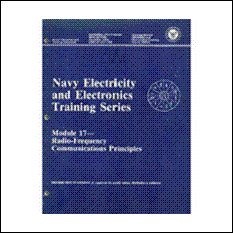Frequency Band Use
Frequency Band Use in RF Communications
Rapid growth in the quantity and complexity of
communications
equipment and increased worldwide international requirements for radio
frequencies have placed large demands upon the radio- frequency
spectrum. These demands include military and civilian applications such
as communications, location and ranging, identification, standard time
and frequency transmission, and industrial, medical, and other
scientific uses.
Below is the radio-frequency spectrum broken down into nine bands used by the military. Propagation of radio waves varies widely at different frequencies. Frequencies and equipment are chosen to meet the communications application desired. We will discuss the radio-frequency spectrum in the following paragraphs.
FREQUENCY DESCRIPTION
30 GHZ - 300 GHZ extremely high frequency
3 GHZ - 30 GHZ superhigh frequency
300 MHZ - 3 GHZ ultrahigh frequency
30 MHZ - 300 MHZ very high frequency
3 MHZ - 30 MHZ high frequency
300 KHZ - 3 MHZ medium frequency
30 KHZ - 300 KHZ low frequency
3 KHZ - 30 KHZ very low frequency
300 HZ - 3 KHZ voice frequency
Up to 300 HZ extremely low frequency
Extremely Low-Frequency Communications
The purpose of the EXTREMELY LOW-FREQUENCY (elf) communications system is to send short "phonetic letter spelled out" (PLSO) messages from operating authorities in the continental United States (CONUS) to submarines operating at normal mission speeds and depths. Elf has the ability to penetrate ocean depths to several hundred feet with little signal loss. This ability allows submarines to be operated well below the immediate surface and enhances submarine survivability by making detection more difficult.
This is a one-way communications system from the operating authority to submarines at sea. The large size of elf transmitters and antennas makes elf transmission from submarines impractical.
Very-Low-Frequency Communications
The communications commitments of the Navy now cover the face of the earth. New sea frontiers to the north have opened a four-million-square-mile, ice-covered ocean of strategic importance. Our Navy must maintain control of the operating forces in an ever expanding coverage area. This additional area requires changes in communications capacity, range, and reliability. Additional needs have been particularly great in the North Atlantic and the newly opened Arctic Ocean. High-frequency circuits are too unreliable in these areas because of local atmospheric disturbances.
VERY-LOW-FREQUENCY (vlf) transmissions provide a highly reliable path for communications in these northern latitudes as well as over and under all oceans and seas of the world. At present, practically all Navy vlf transmitters are used for fleet communications or navigation. The vlf transmission is normally considered a broadcast, that is, one-way transmission, no reply required. The vlf transmitter normally transmits single-channel rtty.
Vlf is currently used for communications to large numbers of satellites and as a backup to shortwave communications blacked out by nuclear activity. Our Navy depends on vlf for crucial communications during hostilities.
Secondary applications of the vlf range include worldwide transmission of standard frequency and time signals. Standard frequency and time signals with high accuracy over long distances have become increasingly important in many fields of science. It is essential for tracking space vehicles, worldwide clock synchronization and oscillator calibration, international comparisons of atomic frequency standards, radio navigational aids, astronomy, national standardizing laboratories, and communications systems.
A vlf broadcast of standard time and frequency signals has more than adequate precision for the operation of synchronous cryptographic devices, decoding devices, and single-sideband transmissions.
Low-Frequency Communications
The LOW-FREQUENCY (lf) band occupies only a very small part of the radio-frequency spectrum. This small band of frequencies has been used for communications since the advent of radio.
Low-frequency transmitting installations are characterized by their large physical size and by their high construction and maintenance costs. Another disadvantage is low-frequency signal reception being seriously hampered by atmospheric noise, particularly at low geographical latitudes.
Over the years, propagation factors peculiar to the low-frequency band have resulted in their continued use for radio communications. Low-frequency waves are not so seriously affected during periods of ionospheric disturbance when communications at the high frequencies are disrupted.
Constant research is being done to improve existing capabilities and to use new systems and developments as they become operationally reliable. In the past, the fleet broadcast system provided ships at sea with low-frequency communications via cw telegraph transmissions. As technology advanced, the system was converted to single-channel radio teletypewriter transmission.
Today "If" communications is used to provide eight channels of frequency-division multiplex rtty traffic on each transmission of the fleet multichannel broadcast system.
Medium-Frequency Communications
The MEDIUM-FREQUENCY (mf) band of the radio-frequency spectrum includes the international distress frequencies (500 kilohertz and approximately 484 kilohertz). Some ships have mf equipment. If desired the distress frequencies may be monitored. When this is done the transmitter usually is kept in the standby position. Ashore, the mf receiver and transmitter equipment configuration is usually affiliated with search and rescue organizations, which are generally located near the coast.
Only the upper and lower ends of the mf band have naval use because of the commercial broadcast band (AM) extending from 535 to 1,605 kilohertz. Frequencies in the lower portion of the mf band (300 to 500 kilohertz) are used primarily for ground-wave transmission for moderately long distances over water and for moderate to short distances over land. Transmission in the upper mf band is generally limited to short-haul communications (400 miles or less).

















